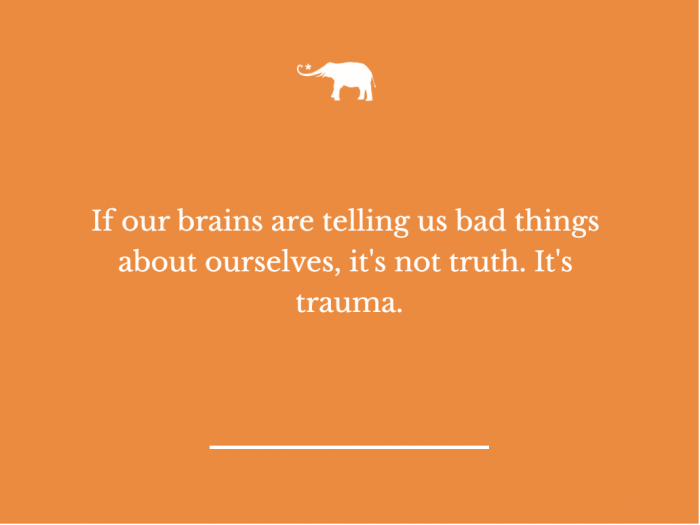Almost all of us have experienced trauma at one time or another – whether through childhood experiences, a car accident or serious illness, or just what life throws at us. Many of us hold on to the pain these traumas cause throughout our lives because we don’t know how to get rid of it. And we’re often affected by the trauma that our parents or grandparents survived, without even knowing it.
This time of year can be a trigger for some of those negative emotions. Family and friend gatherings can cause old wounds to open up or past resentments to resurface. It can be tough to deal with these issues while in the midst of those whom might have caused them.
Dealing with transgenerational trauma and other feelings of emotional abuse is at the center of Sarah Peyton’s work. She believes that if our brains are telling us bad things about ourselves, it’s not truth, it’s trauma.
Peyton is a neuroscience educator, a certified trainer of nonviolent communication and a constellation facilitator, trained to deal with the deepest levels of human suffering through a technique called resonance. She’s written two books on it — Your Resonant Self and Your Resonant Self Workbook, and has helped thousands of people come to terms with trauma in their lives. Now, in her third book, Affirmations for Turbulent Times, Peyton addresses practical life topics like family and home, work and contribution, and environmental awareness. She also delves deeper into emotions and longings, loneliness and community, and mourning loss. And she does it all using relational neuroscience.
Sarah came to learn about relational neuroscience in her own quest to help herself through transgenerational trauma. She grew up in Alaska – a place both of her parents fled to escape their own families in the lower 48. “My mom was an adventurer and had gotten divorced on the East Coast, traveled all over the world, then came to Alaska. She was really a feminist all her life. I think she was trying to leave patriarchy behind. My dad grew up on a multigenerational ranch north of Los Angeles but had a difficult family life and was considered mentally deficient in school. So both came from constrictive pasts and pretended they could start over cleanly. My father worked at the University of Alaska and the scientific belief was that whatever happened to you in the first three years of life was what set your brain in stone. You just were who you were. And you were stuck with whatever anxiety or depression or weirdness or trauma response you had. There was no changing the brain. So you could never get away from your past.”
She found this to be an interesting juxtaposition, as she saw her parents trying to flee their past while at the same time believing they couldn’t. So when she discovered the world of neuroscience, it was like a giant light bulb went on. “It was spectacular,” she says, “because this was the resolution of a fear and a bewilderment that had been with me since I was small.”
Peyton came across the topic in the early 2000s, when all the universities in the U.S. were getting fMRI machines and starting to play with social and relational neuroscience and what human relationships do to the brain. There were groundbreaking books on the subject, like Bonnie Badenoch’s Being a Brain-Wise Therapist, and Daniel Siegel’s early writings including The Developing Mind.
These books heavily influenced Sarah’s perception of relational trauma and made her look deeper. She realized that what she perceived as abuse from her mother was really her mother struggling with memory loss. “She couldn’t remember from one minute to the next. She couldn’t protect me from other people who were abusive because she couldn’t remember that it happened. It was too much stress for her and would cause her to fall into dissociative patterns. It’s part of what makes a child feel crazy. So I started to feel dissociated.”
Through more research and the help of a “pit bull” mentor, Peyton came to discover the power of relational neuroscience and how the brain forms attachments through behaviors and even facial expressions. As a rare book dealer, she’d listen to books by Marshall Rosenberg and Matthew Lieberman on tape during her long drives to and from book sale events.
She even attended an empathy circle – something she had never even heard of before. As part of the circle, she was encouraged to talk about something “bad” while the group listened. So Sarah talked about how she couldn’t hug her adopted son, and how her body would freeze every time she tried. She picks up the story from there. “No one in my life had ever responded by wondering what my feelings and needs were. So I had this sort of transformational experience, where I remembered suddenly reaching for my mother and feeling her freeze when I reached to hug her. She had been so badly abused when she was a child that touch was really tricky for her. But I hadn’t put that together. Once I realized that my baby body was trying to avoid making my mother freeze, I could hug my son. I thought, why did that happen?”
This type of experience is at the heart of resonance. When we name feelings or name what’s true inside of us, it changes the amygdala, the “flight or fight” part of the brain that processes fearful and threatening stimuli and plays a pivotal role in memory. Naming a feeling takes away the fear and trauma associated with it, opening up brain pathways that are blocked by negative emotions. The amygdala relaxes as a result.
Sarah started teaching nonviolent communication at women’s prisons near Portland, Oregon, and it opened up a whole new world for not only her but the inmates as well. “The women loved relational neuroscience — they were just starved for it. It helped them to understand their lives,” she recalls. She went on to professionally teach classes throughout the Northwest and Canada
Sarah also worked with Susan Sky, a trainer in nonviolent communication and neuroscience who developed an approach to healing trauma using time travel. Sarah explains, “The amygdala has no sense of time, it thinks trauma is still happening. That means that any trauma we feel in our bodies is completely accessible to time travel. I studied with her for years to really integrate time travel and resonance into my own work.”
Resonance is defined as a state of deep understanding where things are very fluid in the brain, and injecting warmth while naming negative emotions can help the brain to re-form pathways that focus on balance and healing.
After the publication of her Resonance books, her publisher (W.W. Norton) came to her and asked if she would write a book of affirmations. She didn’t really know what an affirmation was at the time but was willing to try it.
“I had read Melody Beatty’s work about codependency and it was full of affirmations. I gained a lot of passion about affirmations from those pages, and I also drew on my years of experience with resonance. How do we name what’s true to let good things come to us? I knew that people block themselves from believing good things about themselves because the good things are too discordant with their experience of reality. So I wanted to explore how we can name the realness of life in a way that lets the good things come through.”
Affirmations for Turbulent Times sets up “wonderings,” or personal questions, on one side of the page, and truths on the other. The wonderings identify what need to be acknowledged, with affirmations that correlate on the facing page. It’s another form of resonance to help readers get through emotional obstacles to reclaim their inner peace.
“I receive letters every day from people who’ve been in therapy for thirty years saying that resonance is the missing piece, that resonance has allowed them to change,” says Sarah. “We have folks taking this material into their businesses and using it as the foundation on which relational connection with clients and customers is founded. We’re seeing amazing things happen in the world with this material.”
Affirmations for Turbulent Times is available from Amazon, Barnes & Noble and, Norton Publishing. She also offers her books, classes and workshops on resonance and other topics at www.sarahpeyton.com.

 Share on bsky
Share on bsky





Read 0 comments and reply